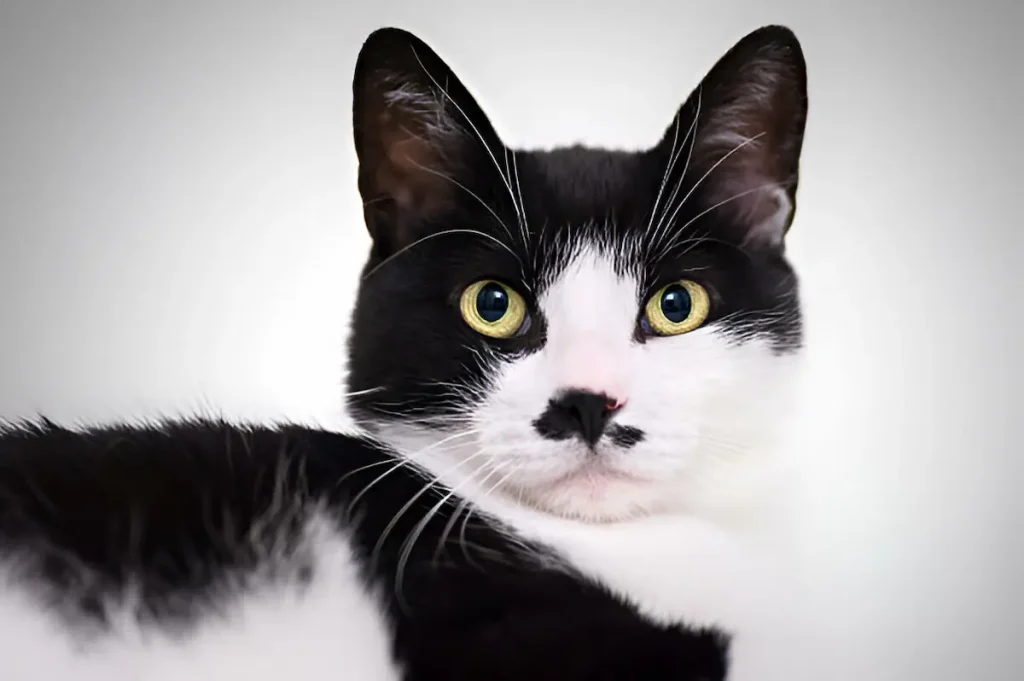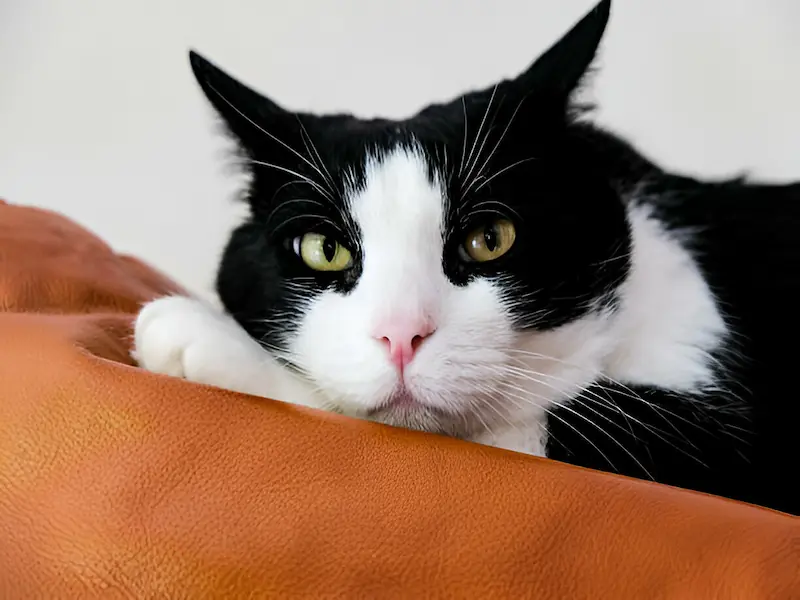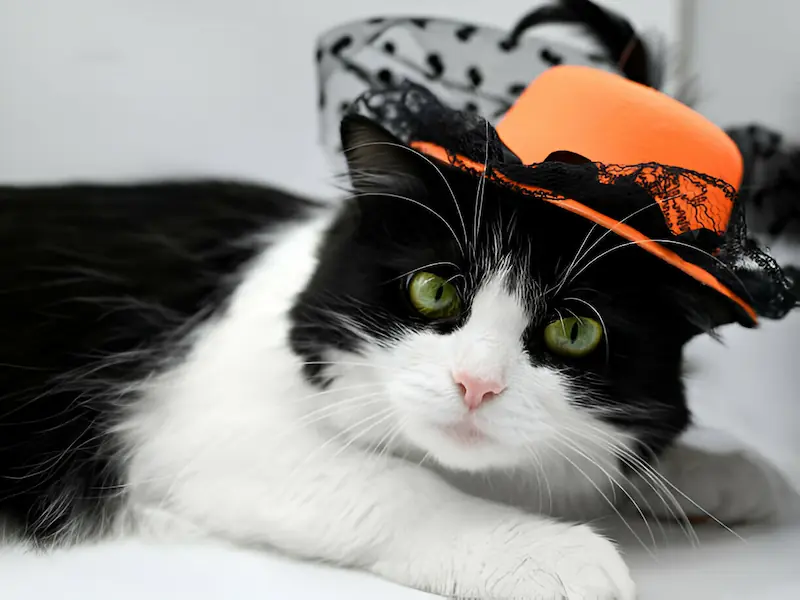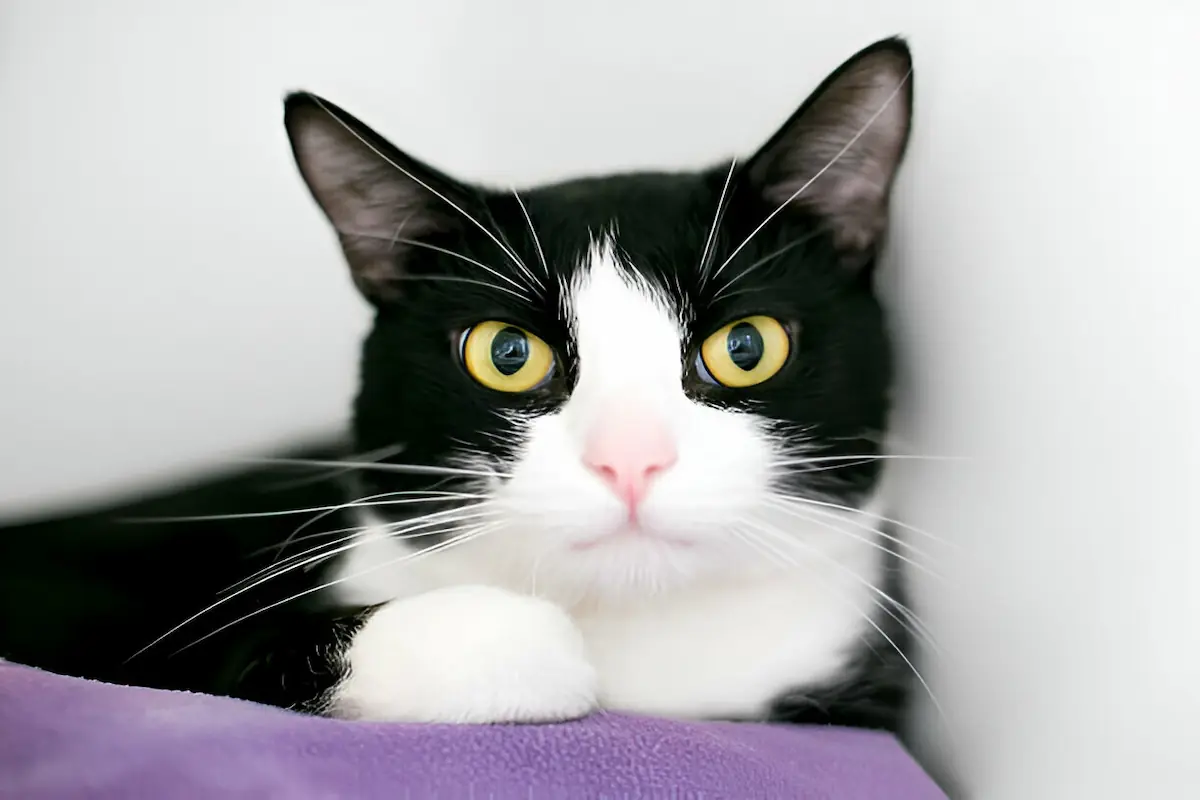Tuxedo cats are one of the most recognizable and adored cat patterns, with their striking black-and-white coats that resemble a formal tuxedo. Whether you’re new to tuxedo cats or already a fan, this guide will take you through everything you need to know about these elegant felines. From their personality traits and care needs to their fascinating history and appearances in pop culture, you’ll walk away knowing all about tuxedo cats.
Tuxedo Cat Personality

Maybe you’re looking for a colorful shelter cat or a specific black and white breed, or you’ve found a stray kitten that looks like it’s wearing a formal suit. Regardless of pedigree, you probably won’t be able to resist the charms of a tuxedo cat. She may be short or long, male or female, and have a striking personality, but one thing is certain: a tuxedo cat is anything but ordinary.
pros
- A charming model that resembles a tuxedo
- Almost all cats can have the pattern
- Different breed standards accept the pattern
Cons
- Some breeds may be subject to certain health problems
- It cannot be bred for specific characters
- Personality traits vary
Related: Are Siamese cats hypoallergenic? Find out the truth!
What is a tuxedo cat?
Tuxedo cats (a.k.a. Felix, piebald, Jellicle, or our personal favorite—the Tuxie) are aptly named for their distinct two-tone pattern. The most common tuxedo model is a black body with a white chest, although a gray kitten with the same coloring could also qualify. Tuxedos also often have white paws.
Downy fur can be long, short, or even curly, although short fur is the most common. Some tuxedo kittens have different types of fur. For example, some have white hair that is much longer than dark hair. These cuties can also have yellow, green, or amber eyes.
Are tuxedo cats male or female?

You might assume that tuxies are mostly girls or mostly boys, but the truth is that it’s about 50/50. Some coats and styles tend to lean more in one direction than the other. For example, the vast majority of red and calico cats are male.
The History of the Tuxedo Cats
In ancient Egypt, cats were worshiped as gods and goddesses. Cats were mummified as royalty and depicted in artwork, hieroglyphs, and statues because they were believed to possess “divine energy.” While this should give all cats an ego boost, it applies even more to tuxedo cats. Almost 70% of the cats depicted in ancient Egyptian tombs and artwork were tuxedo cats.
Thousands of years after their glory days in ancient Egypt, the tuxedo cats continued their reign, serving as companions to Beethoven, Nvidilliam Shakespeare, and Sir Isaac ne Grafton. President Bill Clinton even walked into the White House with his trusty tuxedo cat Socks at his side.
No one knows for sure when this gene combination began to be expressed in cats, but it is thought to date back at least to the ancient Egyptians, as bicolor cats have been identified in their tombs. Tuxedo cats appear throughout modern popular culture.
What is the origin of tuxedo cats?
Although it is small, fluffy hides many big secrets and mysteries… including the answer to this exact question. Simply put, we don’t know exactly where the Tuxedo came from. However, we know that there is evidence of bicolor cats from Egyptian tombs. (We won’t get into how Fluffy managed to convince the ancient Egyptians that she was a deity.)
It’s worth noting that cats aren’t the only species with Tuxedo-like badges. Many fish, for example, have a lighter underside and a darker color on their backs, making them harder for predators to spot. The fish’s dark torso may be difficult for birds to see from above, while the lighter pattern underneath may blend into the water’s surface and appear to be looking up from below.
Related: 17 Exotic Cat Breeds You Can Keep as Pets
Tuxedo Cat Characteristics

Tuxedo is a color pattern that can occur in many different cat breeds. The tuxedo model takes its name from the clothing worn by human men on formal occasions. Nothing is as dramatic as seeing a “tuxedo,” as he is affectionately called, dressed in his bib and his best lapels. Some tuxedos also wear “gaiters” or white boots. This name comes from the word “spatterdash,” a type of lining that covers the instep and ankle area of some shoes.
Because many breeds and mixed breeds can bear the tuxedo pattern, the personalities of tuxedo cats vary much more than their coloring. Each cat’s temperament depends on its genetics and the environment in which it is raised.
Appearance
You will know if a cat has the tuxedo pattern from birth. Kittens are simply miniatures of the adult pattern, rather than having a color pattern that changes as they grow. These black and white beauties come in all shapes and sizes, but always look a little more sophisticated than their counterparts due to their neat tuxedo-like markings. Although gray cats may have a similar two-tone pattern, they are generally not considered tuxedo cats.
Tuxedo cat care
The individual care of a tuxedo cat depends on its breed. Its coat does not require any special treatment according to the color pattern. Brushing your cat reduces matting and can prevent hairballs from forming. Trim your cat’s nails every two to three weeks and give him a scratching post. As with any cat, stay up-to-date on vet visits and vaccinations to prevent health problems.
Give your cat lots of opportunities to play with toys and hunt for toys and provide her with safe places to retreat. Cats like to sleep and nap a lot, so provide a comfortable bed and other places around the living area where your cat can relax.
Cats that live indoors need a litter box in a quiet area. Make sure you completely empty and clean the box at least once a week. Using clumping litter daily and collecting clumps can keep things in order.
Diet and nutrition
Your tuxedo cat should be fed the same as any other cat of its breed. Although it may be festive, your cat doesn’t have to eat caviar for dinner. A wet food diet is often considered the best, but you can also give your cat dry food to snack on. Discuss your cat’s needs with your veterinarian, especially if he has diabetes, is obese, or is elderly. Always provide your cat with fresh, clean water.
Common health problems
Tuxedo cats can come from many different breeds, some of which are more susceptible to certain diseases and conditions. The ASPCA lists these common cat diseases as ones you need to be aware of for every cat:
- Cancer: Cancer is more common in older cats. Look for lumps or unusual skin changes. Lymphoma is a common cancer in cats.
- Diabetes: it is more common in overweight, male, and older cats.
- Feline immunodeficiency virus: It is transmitted from cat to cat when they fight and suffer deep bites. The best prevention is to keep the cat indoors and away from territorial fights.
- Feline leukemia virus: This virus damages the immune system and makes cats more susceptible to developing blood cancers. There is a vaccine that can reduce the risk.
- Kidney disease: a common problem in older cats, kidney disease can lead to organ failure. Some signs of kidney disease include increased thirst, urination, weight loss, decreased appetite, and vomiting. There are various blood tests that can help detect and predict kidney disease earlier than before. Be sure to discuss this screening with your veterinarian.
- Hyperthyroidism: Overactive thyroid glands are also very common in cats. This condition can cause weight loss, increased vocalization, voracious appetite, and sometimes even vomiting or diarrhea. A blood test can help determine whether your cat has this problem.
Types of Tuxedo Cat
The tuxedo pattern is not permitted in some breed standards, but is specified in the Cat Fanciers’ Association (CFA) standards for the following cats:
- Maine coon
- American curl
- Oriental (shorthair and longhair)
- British shorthair
- Sphynx
- Cornish Rex
- Devon Rex
- Peterbald
- Exotic shorthair
- La perm
- Munchkin
- American shorthair
- Norwegian forest cat
- Persian
- Scottish fold
Where can you adopt or buy a tuxedo cat?
Mixed-breed tuxedo cats are common and can be found in adoption shelters, but pure breeds that bear the black-and-white pattern must come from breeders. Check out the American Cat Fanciers’ Association (ACFA) Director of Breeds for reputable breeders in the US.
FAQs
What breed of cat is tuxedo?
There’s no such thing as a tuxedo cat breed
Although there is no such thing as a Tuxedo cat breed, the bicolor (also piebald) pattern is most common in the following cat breeds: Domestic Cat, Turkish Van, American Shorthair, British Shorthair, Cornish King, Exotic Shorthair, Maine Coon, and Mans.
How rare is the tuxedo cat?
The coloration of the Tuxedo is not particularly rare and can be seen in almost all breeds. There is no reason why tuxedo cats should cost more than everyone else.
How aggressive are tuxedo cats?
Yes, they are considered one of the most aggressive feline colors, but that doesn’t mean that every Tuxedo will be a wild child. If you’re a cat lover, this attitude is not a deal breaker.
What can tuxedo cats eat?
Tuxedo cats should receive dry or wet food, depending on their age, activity level, and health status. Fresh, clean water should always be available for cats, the reward amount should be taken into consideration when giving treats, and the cat’s daily calorie intake should be monitored.
Why are tuxedo cats not a breed?
When we talk about tuxedo cats, we are referring to a specific coat pattern of a domestic cat. It is not another breed of cat like a Bengal cat or a Sphinx cat. Tuxedo cats get their name from the typical color pattern.
Are tuxedo cats more expensive?
A tuxedo cat can cost between $50 and $200 if you decide to go for it, or between $500 and $1,000 if you buy it from a good breeder
What breed are tuxedo cats?
What breed of cat does a tuxedo cat belong to? Although there is no one breed of Tuxedo cats, the two-tone pattern is most common in the following cat breeds: Domestic Cat, Turkish Van, American Shorthair, British Shorthair, Maine Coon, and Mans.
Are tuxedo cats hypoallergenic?
No cat is completely hypoallergenic. However, people with allergies may find that they are less irritated by some breeds that produce less dander and saliva, such as the Sphinx and Devon. If you’re thinking about adopting a tuxedo cat, make sure you know their breed so you can get an idea of the potential for allergens.
Are tuxedo cats a breed?
I wait. Like the calico and tortoiseshell, tuxedo cats are not a breed. Instead, they are distinguished by their distinct black and white two-tone (or piebald) coats that are reminiscent of traditional evening gowns. While Calico and tortoiseshell cats are predominantly female, tuxedo cats can be either male or female.
Are tuxedo cats always male?
While some coat variations in cats are found on the chromosome, causing most ginger cats to be male, this is not the case in tuxedos. Tuxedo cats are equally likely to be female, although many consider them Male due to their chic evening attire.
black and white cat race
cow cat
tabby cat

